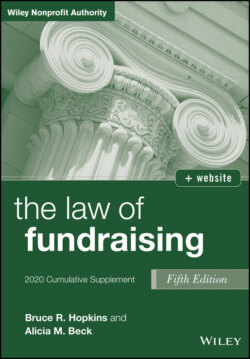Читать книгу The Law of Fundraising - Bruce R. Hopkins - Страница 13
§ 1.4 CONTEMPORARY REGULATORY CLIMATE
Оглавлениеp. 19. Insert following second complete paragraph:
In September 2016, a study, conducted by the Charities Regulation and Oversight Project at Columbia Law School and the Center on Nonprofits and Philanthropy at the Urban Institute, was released. This is the first organized analysis of state‐level oversight and regulation of charitable organizations. The study has three components: (1) a legal analysis of laws pertaining to charities in 56 U.S. jurisdictions; (2) a survey of state and territory offices with oversight, regulatory, and enforcement authority over charitable organizations; and (3) interviews in most of those offices. Major findings of this study include the following:
There is no single state law of charities oversight; rather, this oversight entails a complex mix of substantive areas, including charitable trust law, governance, criminal law, solicitation and registration requirements and compliance, corporate transaction review, and conservation easements.
Organization and staffing of state charity offices vary greatly; in 41 percent of the states, one office has primary responsibility, while in the other states responsibility is shared with other agencies or offices.
Within an attorney general's office, 13 jurisdictions have a charities bureau; 14 jurisdictions house charities oversight within a consumer protection division.
Most registration oversight is lodged in state attorney generals' offices (21 states), followed by offices of the secretary of state (15 states), and other state‐level charity offices, usually consumer affairs or business/financial regulation (8 states).
Lawyers and nonlegal staff who oversee charities number approximately 355 in the 48 reporting jurisdictions.
Thirty‐one percent of jurisdictions have less than one full‐time‐equivalent staff in this area, 51 percent of jurisdictions have between 1 and 9.9 full‐time‐equivalent staff, and 19 percent have 10 or more full‐time‐equivalent staff.
Training of state charities regulation staff is a mix of internal and external provision, with the smaller offices less likely to provide any training and the largest offices providing in‐house training.
States have different requirements for reporting by charities. Some rely on reporting on IRS annual information returns,60.1 some require registration information, and some require independent audits and notification of certain transactions.
In the 47 responding jurisdictions, 68 percent require fundraisers for charitable organizations to register, and 60 percent require charities to register.
Twenty‐two states require charities to file independently audited financial statements; most of the jurisdictions requiring these audits have a $500,000 threshold before an audit is required.
Where charities must inform the attorney general's office of major transactions, the top three triggers of this notice requirement are mergers (43 percent), voluntary dissolution (41 percent), and sale of assets (33 percent).
The three most common areas of enforcement by charity offices are fundraising abuses (62 percent), trust enforcement (36 percent), and governance (36 percent).
Of the fundraising methods overseen by state charities officials, the most common areas of oversight are telephone solicitations (82 percent), direct mail (80 percent), special events (80 percent), in‐person solicitations (80 percent), Internet‐based fundraising (76 percent), and social‐media–based solicitations (70 percent).
State‐level enforcement actions are more likely to be informal resolutions (85 percent), involve correspondence with organizations (98 percent), settlements (88 percent), fines and penalties (80 percent), or formal litigation (e.g., injunctions) (79 percent).
Offices vary in their efforts to provide education and outreach to the fundraising community, ranging from press releases (82 percent) to donor advisories (77 percent), training (32 percent), and webinars (7 percent).
